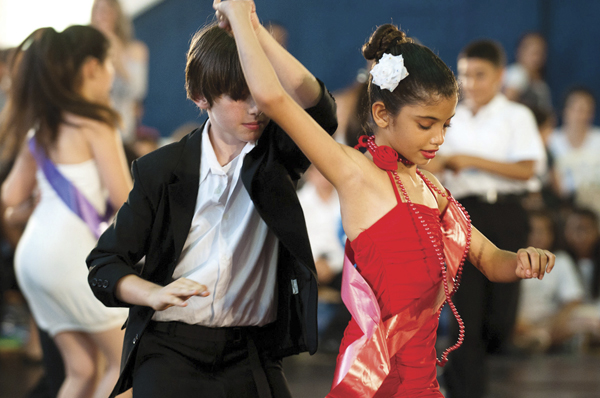In 1994, four-time ballroom dancing world champion Pierre Dulaine and his dance partner, Yvonne Marceau, started an educational program called Dancing Classrooms. First introduced in New York City, its goal was to introduce ballroom dance to inner city fifth graders as a means of teaching respect, breaking down social barriers, and improving self-esteem. Twenty classroom sessions were followed by a competition cycle that paired children of different cultures and ethnicities as partners. The success of the program inspired Dulaine to take it to the city of his birth, Jaffa, Israel, to bring Jewish and Palestinian Israeli children together through dance.
The Mediterranean port city has been home to both Arabs and Jews since the 19th century, but in 1948 the Arab-Israeli war forced tens of thousands of Palestinians to flee, including Dulaine’s own family. This is the first time he has visited the city since his forced expulsion. Opening scenes of fishing boats and dusk settling over the lighted clock tower with the sea glowing just beyond are visual similes for a hopeful beginning, but the reality of what Dulaine is up against is soon revealed in the gated entrances to the schools and the hard set of the parents’ faces when they hear the details of his program.
Dulaine eventually convinces five of the schools to participate: two Jewish, two Arab, and one mixture of Jewish, Muslim and Christian students. One of the first obstacles he has to overcome is persuading the boys and girls to make contact with each other, particularly in the Palestinian-Israeli schools where physical contact between Muslim boys and girls is considered taboo. He calls in his partner, Yvonne Marceau, to help him accomplish this task. Once the initial 20 sessions are completed and the final dance participants are chosen, he encounters the biggest hurdle of the entire project when he pairs the Palestinian Israeli and Jewish children as dance partners.
The film provides glimpses into the lives and particular issues faced by three of the students: Noor, a sullen, angry girl who lost her father when she was six and whose Jewish-turned-Muslim mother was recently fired from her job; the always smiling Alaa, whose large family lives in abject poverty; and Lois, whose determined Jewish mother believes winning is everything.
All three are among those chosen to participate in the final competition. Throughout the film, there is footage of the many ways in which the conflict between the Arabs and Israelis is perpetuated in the daily lives of the students: armed Israeli guards in the streets, a Jewish right-wing demonstration that parades through the city, and a Jewish holiday in celebration of the acquisition of Jaffa that is marked as a day of mourning by the Palestinian residents. All punctuate the seeming impossibility of Dulaine’s undertaking. Yet, as the final competition draws near, the positive impact of the program on both the children and their parents becomes irrefutable.
Dancing in Jaffa will surely garner a major increase in financial support for Dulaine’s Dancing Classrooms program, but it also serves as a viable light at the end of the long, dark tunnel of cultural and religious conflict around the world.







Leave A Comment